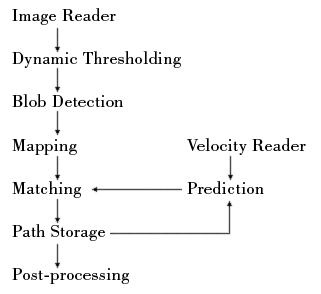 Particle Tracking Velocimetry (PTV) is an extension of the PIV technique, wherein individual particles are tracked to measure the discrete velocity of each (as compared with PIV, which discretizes regions of a given size). Particularly, PTV involves more post-processing in order to determine minute motions and particle rotation. The process also increases the resolution and accuracy. A complete picture of the motion of even a single particle can be seen, as opposed to a particle's motion within a discrete 'zone' of the total imaging area. Combining PTV and PIV is sometimes known as Hi-res Particle Velocimetry (HPV), and yields information 10 times as detailed. A third camera can be added to the HPV method to determine fully 3D particle motion.
Particle Tracking Velocimetry (PTV) is an extension of the PIV technique, wherein individual particles are tracked to measure the discrete velocity of each (as compared with PIV, which discretizes regions of a given size). Particularly, PTV involves more post-processing in order to determine minute motions and particle rotation. The process also increases the resolution and accuracy. A complete picture of the motion of even a single particle can be seen, as opposed to a particle's motion within a discrete 'zone' of the total imaging area. Combining PTV and PIV is sometimes known as Hi-res Particle Velocimetry (HPV), and yields information 10 times as detailed. A third camera can be added to the HPV method to determine fully 3D particle motion.
Because of the intent to track individual particles, fewer particles are used in order to avoid confusing the algorithm. Commonly this is held as a weak data gathering technique, however, proponents of the method illustrate its increased precision yields better information in some scenarios than the heavy seeding typical to PIV. An under-rated technique, it is used primarily by universities and engine manufacturers. Over, this combination of PIV and PTV is a recent marriage, and only documented at a highly-technical level.